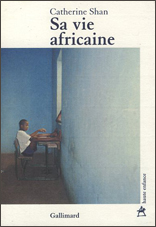|
NOT TO BE MISSED "Sa vie africaine", a novel by Catherine SHAN Paris: Gallimard, 2007. (100p.). ISBN 978-2-07-078364-9.
|

Ce compte rendu en français |
Sa vie africaine [Her life in Africa] is a penetrating novel about grieving and family relationships. It tells the story of a middleclass French woman who fell pregnant to an African student in the 1950s, married him and moved to Africa where she spent many years, first with her husband and later, on her own with her two children. When she passes away, her daughter Catherine begins digging deep into the family history and wings her way back to the harrowing times of her mother's youth. As she peruses the personal papers and photographs lying around the family home, her mother's life in Africa, her parents' divorce and the perennial breakdowns that marred family relationships flood back into her mind.
 This journey down memory lane allows Catherine to understand better the significance of her mother's "African experience". It testifies to the departed's independence, strength and lifelong determination to remain in charge of her destiny. It also brings Catherine to realise the importance of her loss as she attempts to come to terms with her grief: the woman who she could least understand over the greater part of her life was indeed the one she was missing most, once she was gone. Sa vie africaine is definitely a fascinating exposé of a mother-daughter relationship, but it is also an interesting novel on account of its original narrative technique that follows the haphazard uncovering of long-lost photographs and ascribes to them the attribute of historical truth.
This journey down memory lane allows Catherine to understand better the significance of her mother's "African experience". It testifies to the departed's independence, strength and lifelong determination to remain in charge of her destiny. It also brings Catherine to realise the importance of her loss as she attempts to come to terms with her grief: the woman who she could least understand over the greater part of her life was indeed the one she was missing most, once she was gone. Sa vie africaine is definitely a fascinating exposé of a mother-daughter relationship, but it is also an interesting novel on account of its original narrative technique that follows the haphazard uncovering of long-lost photographs and ascribes to them the attribute of historical truth.
The visual representation of the past that these snapshots offer, encapsulates the mood and activities of the protagonist at different times of her life. This provides the narrator with endless prompts that jog her memory and allow her to reconstruct an image of the past that sheds new light on her own souvenirs and family lore. The emphasis on the visual coming to the rescue of both dry historical facts and people's inventive recollection of times-gone-by, is obvious from the very first lines of the novel: "In Niger, she is smiling at the wheel of her Jeep that has the number plate registration 100. One can see that she has got a small tooth missing. That does not prevents her from smiling, one hand resting on the wheel, the other on the enormous gear-stick. She is twentyfive, she likes to be photographed with her cars on every occasion, in Africa and later on too. She belonged to a generation of women to whom cars had been an important item and they remained so throughout her life." (p.11)
This family snapshot tells it all. In the twinkling of an eye, one discovers the definitive portrait of a self-assured woman, brimming with energy and determined to remain in charge of her life in spite of the diktats of social and familial conventions. She is not the kind of person to collapse under family pressure or public opinion, nor one to dwell on regrets, and she always manages to turn the tables. Kicked out of home and separated from her first child at birth, she finds work as a relief teacher in a very small country town and succeeds in getting her daughter back, marries her African sweetheart and follows him to Africa on her own accord. Other pictures tell the same story; that of an extroverted character who kept her stamina, her sense of direction and her fancy for cars till the end of her life.
Her African sojourn best illustrates her spirit. She is always on the move, in control, and leading from the front. "She followed her husband to Africa, but it was she, who always took her place in the leading truck when they went on expeditions in the bush." (p.15) It was her husband's professional imposition that dictated the family's moves across the continent, but it was she who was the principal architect of the family settling-in to the foreign places to where they were sent; she was the one entertaining the local establishment, the one securing new teaching jobs wherever they went. "Here, she is smiling again, next to her 'excellence awardee', a skinny boy, black as charcoal, wearing military clothes and thongs cut from old rubber tyres. He is as tall as her and beams with the same radiant smile. She taught him French and arithmetic and succeeded in him getting the School Certificate in record time .... On school photographs from Niger, Senegal or Upper-Volta, she looks like a child amongst the other children. One has to look carefully to find her, lost among her pupils, often one hand on her hip." (p.16)
But as author Paul Auster once said, pictures do not lie, but neither do they tell the whole story, and the overall image of Catherine's mother that emerges from the narrator's perusal is a case in point. As she unearths photos of the family from the time they lived in Madagascar, she is struck again by the similarity of these shots with those taken fifteen years earlier. Her mother's posturing amidst her school-children has not changed. "It is still the same picture", the narrator comments, "She still looks as young as ever." (p.16) It is as if time had suspended its flight: but it has not. There are things the pictures do not say: "She was in Madagascar, but we no longer lived with our father." (p.16)
Important bits of information are clearly missing from the pictorial representation of Catherine's mother. It is as if her life had been portrayed according to her fancy – or that of the photographers – rather than reality. Thus Catherine's paradoxical feeling that all those images were somewhat of a lie, yet telling the truth. Family opprobrium, divorce, difficult relationship with her children and all kinds of personal difficulties never made it into the record. It was as if they were of no importance compared to her determination to embrace life unhindered and to explore the world. While the pictures are telling the story of a radiant woman in charge of proceedings, her path is littered with the remnants of ill-fated relationships with men and women who resisted her challenge to traditional wisdom and conventions. She fell foul of her father trying to hide his métis grand-daughter, of her husband's egress from his commitments, of defiant expedition hunters, of gossiping compatriots; as a matter of fact, of the many people who offended her sense of justice. "My mother was on the side of truth", Catherine says, "And for a long time I thought that it was often bordering on madness." (p.56)
What the pictures do not say either, is that every victory over dishonesty and deceit she tallied also brought its share of hardship and hurt. Her rich father provided her with very little help in her hour of need, her husband left, locals looked at her with suspicion, rumours spread by colonial gossipers are easy to guess and her daughter found it hard to be the child of such an overpowering personality. That, however, Catherine's mother did not dwell upon and expected her children to do the same. To her, the fact that her offsprings were born to a white mother and a black father in the 1950s, that they crisscrossed Africa at the heels of their parents, and had to follow their mother's peregrinations after her divorce, did not register as legitimate reasons to anguish or complain. Yet, these were the real issues that bothered Catherine, explaining, at least in part, her progressive estrangement from her mother. All the "non-dit" behind the photographs, all that had been erased or ignored was, possibly, more important to Catherine than the story on display: one that was fabricated by both the photographer who took the shots and a somewhat self-conscious subject posing in front of the camera.
As it turned out, none of the big hopes and dreams of Catherine's mother survived her African sojourn. African independence did not bring peace and prosperity to Africa; her estranged husband's prospecting for uranium, bauxite and crude oil only led to the destruction of indigenous cultures, while French attitudes towards the inhabitants of her former colonies changed little. As Catherine grew up to become an adult, these were the evils confronting her, both in France where she settled and in countries such as Congo where she returned many years after her parents' divorce, only to find a country thrown into disarray by internal feuding, racketeering and random killings. But to her mother, it was not the ill-fated results of her endeavours that counted but rather the drive to keep moving forward. The words "surrender" and "defeat" were never part of her vocabulary and her attitude in the face of death made no exception. To the bitter end, she never lost her will to live.
In securing the spaces and opportunities that would allow her to leave behind cumbersome social conventions and the hypocritical demeanour governing the life of her family and contemporaries, Catherine's mother embarked on a life-journey full of drama and excitement; but Catherine Shan's novel goes beyond the delusion of romanticised representation and attempts to decipher the untold story hidden outside the picture frames. It gauges the real cost of honesty, truth and determination, exposing the reasons that led to the difficult relationship the narrator entertained with her mother. Was it love that lead the narrator to seek a better understanding of the departed? Was it puzzlement, or a troubled conscience? A bit of all of those probably, as "one needs very little effort to understand someone. But if one does not take the time to do it, one remains with one's grief, with one's unanswered questions." (p.88) Sa vie africaine is certainly a highly affective novel: one well worth reading.
Jean-Marie Volet
[Other books] | [Other reviews] | [Home]
Editor ([email protected])
The University of Western Australia/School of Humanities
Created: 01-January-2011
https://aflit.arts.uwa.edu.au/revieweng_shan10.html